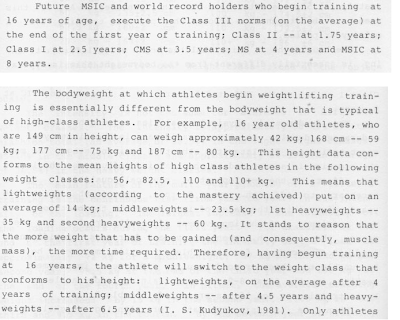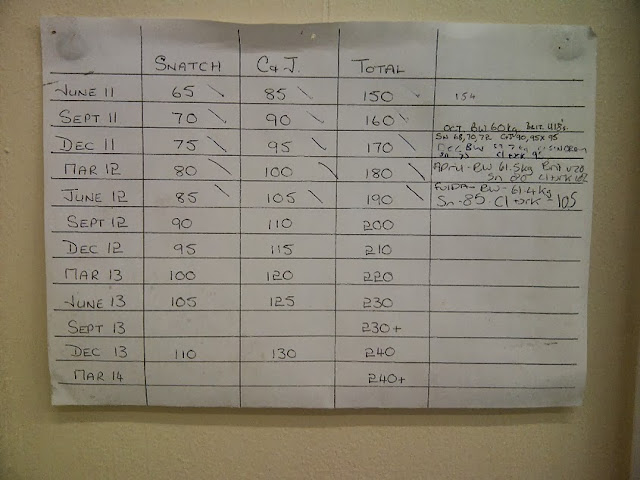Extracts from 'Takano - Weightlifting Programming'
Qualification levels used:In the perfect model, athletes in [Class III] are between 12 and 17 years of
age. Prospective talents should not spend more than 2 years in [Class III], and
most will achieve the levels of the next class in a year of training. For those athletes who
are especially prodigious in their talent, they may need no more than 3 or 4 years to move
from Class 3 to Candidate for Master of Sport.
Class 3 athletes, as a group, are in need of many influences if they are to embark on
successful careers as weightlifters. Not only are they in need of the proper training and
technical lessons, but they are often lacking in their capacities to pursue goals, and to live
the type of life that will enable goals to be realized.
Class 2 lifters are still living their lives as amateurs. The training is not creating such
a demand on energy and time resources that the athletes cannot engage in other full-time
activities such as employment or meaningful education. The increase in time demands,
however, will require improved time management skills and a possible re-inspection of
one’s personal goals.
Class 1 lifters are in the upper reaches of the avid hobbyist stage. They are at a point in
their development where their technique is highly refined. Their speed characteristics, if
not highly developed, are approaching their ultimate levels. They are beginning to be in
need of periodic dedicated restoration. They are performing less GPP. Hygienic and nutritional
factors play a larger role in the training process.
A Candidate for Master of Sport (CMS) athlete is moving toward either being a lifestyler
or paraprofessional. The training demands coupled with the necessity for restoration time
and feeding create a situation that makes full time employment either impossible or overly
demanding. A CMS lifter is often qualified for national level competition, and is adroit
at performing on the competition platform. He or she may have already qualified for a
minor level international competition especially at the junior level, and is sophisticated in
the skills of traveling to a national competition. CMS is considered the last classification
before entering the high mastery stage.
The Master of Sport Athlete is a weightlifter that is the equivalent of a full time professional.
Master of Sport is considered the lowest stage of the High Mastery category. Because
of the number of times training per day, the amount of time devoted to pre-workout
and post-workout restoration, as well as the numerous feedings that are an absolute
necessity, a Master of Sport weightlifter will not have enough time, nor energy, to work
for a living. Support for these athletes in many countries is provided by the government
through the national Olympic Committee. In some situations, a wealthy benefactor can
provide support for a promising and talented lifter. Still in many sports in many countries,
financial support comes from parents and family.
The International Master of Sport is the highest classification. It is based on the average
of 8th place at the world championships and Olympic Games of the preceding quadrennium.
If one is to consider the qualifying totals for this class to be 100% figures, the percentage
gap between this class and the next lowest one (Master of Sport) is the greatest.
The percentage difference here is approximately 20%, whereas the differences between
the lower classes are in the single digits.
Older Soviet standards
More similar to standards used in Soviet Union
Time to reach each class
Extract from 'Roman - Training the Weightlifter'
Referring to older Soviet qualification levels (adjusted for modern weight classes above)
Estimated progression rate
Maybe some other book, maybe Roman's, can't remember
Planned progression for a junior lifter at my gym (Ryan Baugh, currently in -69)





No comments:
Post a Comment